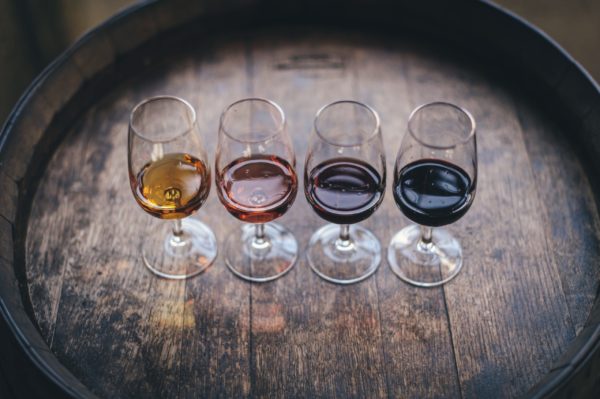If you like sweet wines, you’re probably well-versed in the likes of Moscato and sweet rosé. But did you know there is a huge variety of sweet wines on the market? In addition to naturally sweet wines, some winemakers even take extra steps to sweeten their wine or fortify it with extra liquor.
Sweet wines can be incredibly delicious and come in various styles, from reds, whites, rosés, and even sparkling wines. Whether naturally sweet or fortified, sweet wines are usually extremely flavorful and a pleasure to sip.
The history of sweet wines
Since the wine world is usually dominated by dry or off-dry styles of wine, you may think that sweet wines are a newer invention. But did you know that sweet wines were once the most coveted style of wine in the world? In fact, the world’s first demarcated wine region was an area in Eastern Hungary that specializes in sweet white wines, called Tokaji.
Sweet wines used to dominate the wine world for a variety of reasons. Sweet wines were the most stable, and before modern winemaking and refrigeration, the easiest way to stabilize wine was to increase the sugar content. This was often accomplished using the passito method, which dried the grapes in the sun after harvest.
Additionally, some of today’s prominent wine regions used to be known for sweet wines. For example, Barolo, a well-known Italian red wine, used to be far sweeter than it is today.
Advancements in winemaking technology caused a movement towards dry wines around the 1970s. This shift is partly due to the market being flooded with sweet, low-quality table wines in the 1960s and 1970s, leading wine critics and consumers alike to favor drier wines and view them as higher-quality.
Today, sweet wines are still less popular than dry wines. Sweet wines are usually exclusively served as aperitifs or dessert wines. However, just because sweet wines aren’t as popular doesn’t mean there aren’t some incredibly delicious sweet wines on the market today.
Sweet wines: natural vs. fortified
There are two different ways to produce sweet wine. The first method is natural sweet wine production. Wine is produced by adding yeast to crushed grapes. The yeast consumes the grape sugar and produces alcohol. To produce a naturally sweet wine, winemakers stop the fermentation process early, leaving a large amount of residual sugar in the wine. This residual sugar makes the wine sweet and fairly light when it comes to alcohol content.
The second way to make a sweet wine is to use fortification. Fortified wines have a distilled spirit added, usually brandy, to boost the alcohol content. When fermentation is stopped early, the alcohol content of the wine is lower. Spirits are added to boost the alcohol content and balance out the sugar content in the wine. There are a huge variety of fortified wines made around the world, both reds and whites. Fortified wines are usually much sweeter and much more alcoholic than naturally sweetened wines.
The sweetest wines on the market today
There are various sweet wines produced around the world, both red and white, natural and fortified. Here are some of the sweetest wines available today.
Moscato d’Asti
From Piedmont, Italy, Moscato d’Asti is a sweet, aromatic white wine that is incredibly easy to sip. Moscato d’Asti comes in either a frizzante (lightly sparkling) or spumante (full sparkling) style. The nose usually provides aromas of peaches, fresh grapes, orange blossoms, and Meyer lemons. The flavors will tickle your tongue, both from the acidity and the carbonation. A typical bottle of Moscato d’Asti has 90–100 g/L of residual sugar.
Popular bottles of Moscato d’Asti include Stella Rosa Moscato d’Asti, Saracco Moscato d’Asti, and Risata Moscato d’Asti.
Tokaji aszú
Tokaji Aszú is an extremely sweet Hungarian white wine. It’s made mostly of rare Furmint grapes, purposely infected with a special rot called Botrytis cinerea. The rot concentrates the grape’s sugar and adds distinct aromas of ginger and saffron. The wine is medium-bodied and offers flavors of tangerine, apricot, honey, ginger, and marzipan. Tokaji Aszú can have a residual sugar level of anywhere from 60–450 g/L.
Royal Tokaji 5 Puttonyos is a great Tokaji Aszú for new drinkers to try.
Sauternes
Grapes for Sauternes wine are grown in Bordeaux, along the Garonne river. This area is very moist and foggy, perfect conditions for developing the beneficial rot Botrytis cinerea. Sauternes is made from a blend of Sémillon, Sauvignon Blanc, and Muscadelle grapes, which offer marmalade, honey, butterscotch, coconut, ginger, and spice. Sauternes is an extremely sweet wine with around 120–220 g/L residual sugar.
Great examples of Sauternes include Château Cantegril Sauternes, Marquis De Chasse Sauternes 04 Sauternes, and Chateau du Pouys Sauternes Sauternes.
Beerenauslese riesling
Beerenauslese Riesling is a German Riesling. There are several classifications of German Riesling, with Beerenauslese Riesling being one of the most popular and one of the sweetest. To produce the sweetest possible wines, grape harvesters hand select grape benches that have been infected with noble rot. Beerenauslese Rieslings are incredibly sweet and textured, with tingly acidity. Wines have 90–220 g/L residual sugar.
Popular bottles include Dr Heidemanns Beerenauslese Bear and Weingut Keller Pius Rheinhessen Beerenauslese Riesling.
Ice wine, or eiswein
Another German invention, Ice Wine, gets its name from its unique production method. Grapes are left on the vine into the winter until they freeze. They are then pressed while frozen, so only the sugar oozes out. This syrup-like liquid is then fermented and turned into extremely sweet wine. Popular varieties of grapes used for Ice Wine include Riesling, Vidal, and Cabernet Franc, which offer pineapple, lemon curd, honeysuckle, apricot, and lychee. The residual sugar level is usually around 120–220 g/L.
Popular Ice Wines include Inniskillin Vidal Ice Wine and Neige Ice Wine.
Rutherglen muscat
Rutherglen Muscat is made from Muscat Blanc à Petit Grains, a rare red-colored Moscato grape growing in Victoria, Australia. The grapes are harvested late in the season when they become dried, so the sweetness is incredibly concentrated. This makes the wine incredibly sweet, with unique aromas of toffee, dried strawberries, and hazelnuts. Bottles can have anywhere from 200–400+ g/L residual sugar.
Popular bottles include Campbells Rutherglen Muscat and Chambers Rosewood Rutherglen Muscat.
Vintage port
The Douro Wine region in Portugal, where Port is produced, was the world’s second officially demarcated wine region. Port is usually an incredibly sweet, fortified red wine, but you can also find white Ports. There is a huge range of quality for Ports, as there are so many styles. High-quality vintage years include 2017, 2011, 2007, 1997, 1994, and 1992. High-quality vintage Ports are usually incredibly sweet, full-bodied, and offer plum, dried cherry, chocolate, raisin, and cinnamon. Flavors Bottles can have anywhere from 90–140 g/L residual sugar.
Great bottles of vintage Port include Dow’s Vintage Port, and Quinta do Noval Vintage Port.
Recioto della valpolicella
Valpolicella is a wine region near Verona, Italy. Today, Valpolicella is known for bold, dry Amarone wines. In the past, however, Valpolicella was known for Recioto della Valpolicella. Recioto della Valpolicella is produced using the passito method, which involves drying the grapes on mats before fermentation to concentrate the sugars. This wine is incredibly sweet and offers flavors of chocolate and cherry. Residual sugar levels are usually around 110–200 g/L.
Popular bottles include Recioto della Valpolicella Valpantena, and Giuseppe Quintarelli Recioto della Valpolicella Classico DOCG.
Pedro ximénez
Pedro Ximénez, also called PX, is a sweet sherry wine produced in southern Spain. The production process involves allowing the wine to age in barrels for many years, which causes the liquid to turn almost brown-ish. Over time, the water and alcohol slowly evaporate, which concentrates the sugar level. PX wines can have residual sugar levels of 300+ g/L.
Popular bottles of PX include Osborne Pedro Ximenez Sherry and Gonzalez Byass Nectar.
Pedro Ximenez.
The takeaway
In the fine wine world, dry wines are sometimes considered superior to sweet wines. This is due to various factors, which have to do with a surplus of low-quality sweet wines that gave dessert wines a bad reputation. But just because dry wines may be more popular doesn’t mean there aren’t a huge variety of amazingly flavorful sweet wines on the market today.
It doesn’t matter if you like your wine sweet or dry; Saucey will bring your favorite bottles right to your door. We offer speedy delivery and no order minimums, so your wine, beer, and spirits will be at your door in a flash. Shop our extensive selection and pick up your favorite adult beverages today.




